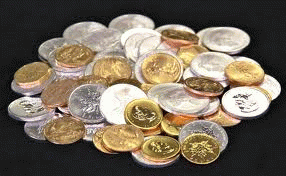The demand for physical possession of bullion rose so strongly that large wholesalers such as http://www.tulving.com and large retailers such as Gainesville Coins reported sold-out items. Also, dealers raised the premiums above the spot price that is charged for coins. From Friday to Monday the premium on Silver Eagles at the large online retailer, Gainesville Coins, rose from $3.75 to $5.99 above the spot price of silver. The percentage increase in premium was larger than the percentage decline in the silver price. Thus, the price of a silver one Troy ounce coin did not drop despite the drop in the spot price. Today (April 16) the price of a silver eagle purchased with a credit card from retailer Gainesville Coins is $30.36. You would never know that the market had fallen out.
What I am reporting are facts, not a theory. We have just had two days of massive sales of paper claims on bullion, but during these days when the price of gold and silver collapsed under short sales, it was difficult to get your hands on the metal itself. On telephone orders you wait in long queues to place an order and are told that delivery awaits availability.
Listening to the media and to academic economists such as Paul Krugman, you would think no one any longer wants gold and silver. But try getting your hands on some.
The physical bullion market, gold especially, is dominated by Asians. Americans are a minor player. Most Americans still believe in the almighty dollar, but few Asians do. The Chinese tomorrow would dump their two trillion of US dollar-denominated assets and purchase gold, except that the action would drive down the dollar and drive up the gold price. So, unlike the orchestrated attack on gold, China plays a slow hand, using the orchestrated attack on gold to acquire the metal at lower prices.
As I understand it, the open interest or future contracts on COMEX greatly exceed the bullion available for delivery. This is a paper market mainly settled in cash, not by taking delivery. If the contracts had to be settled in bullion instead of cash, the COMEX would fail.
One advantage of growing old is that one gains perspective. I remember when gold was $35 an ounce and silver $1 an ounce. If memory serves, until sometime in the 1960s, a person could still take a a paper dollar to a bank and be given a silver dollar. There were $1 dollar and $5 dollar silver certificates (paper money) that circulated along with Federal Reserve currency. At that time banks did not differentiate. A dollar was a dollar. Silver certificates today have collectors' value, but the Federal Reserve currency does not.
If memory serves, sometime after 1966 if a person presented a silver certificate to a Federal Reserve Bank, he received one or five ounces or raw silver in return depending on the denomination of the certificate, which looked like a Federal Reserve note except it said Silver Certificate. I have some of these envelopes of little pieces of silver.
When silver was taken out of US coins in the 1960s and copper was taken out of the US penny in the early 1980s, despite my opposition as Assistant Secretary of the US Treasury for Economic Policy, all real constraints on fiat money were removed.
Today we see the Fed protecting its protection of "banks too big to fail" with low interest rates by creating enormous sums of money in order to purchase both Treasury bonds and mortgage backed derivatives.
These Fed purchasers are at the expense of savers and CD and bond purchasers who receive a negative real rate of interest.
Now, to protect its bank rescue policy, the Fed is attempting to drive down the price of bullion, thus depriving Americans of any way of protecting their life savings from the inflation that the Fed's money printing will ultimately cause.
Save a handful of corrupt banks, screw the American public--that is the Fed's policy. Like almost every other American institution, the Fed represents the mega-rich.
Anyone with open eyes can see that it is impossible for the US dollar to maintain its current exchange value and role as world money when its supply is being increased by $1,000 billion per year while the world is ceasing to use the dollar for international payments.
The attack on gold is a desperate attempt to protect the US dollar from the Fed's policy of quantitative easing. But the attack on bullion has apparently failed. The price was driven down, but the demand for physical possession has hit new highs.
(Note: You can view every article as one long page if you sign up as an Advocate Member, or higher).






